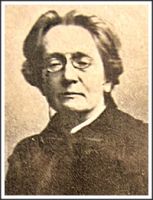Maria Dulebianka
Why do we consider this woman to be an important person?
Maria Dulebianka
was a person who knew how to live in accordance with her own convictions and
passions. She was able to stand up to the existing social schemes.
Painting was her passion, so she fought for the possibility to get an
appropriate education. In the Krakow Academy of Fine Arts women were not
accepted so she went to Vienna and Paris to learn from the
best. The theme of her work were women. Despite of achieved successes she gave up her
career and became involved with the famous writer Maria Konopnicka. Their
relationship lasted 20 years.
Her life experiences are associated with the activities for the equality of
women. She fought for women's right to study at universities and demanded
voting rights for women.
Biography
She came from a family of landowners. Till 1872 she lived in Krakow, where she finished school and studied painting
under the direction of Jan Matejko. She could not study at the Krakow Academy
of Fine Arts because only men could become students.
She continued her studies at Academies Julian in Paris
and Vienna.
In 1896 after returning from a trip to Italy
and the Crimea she settled in Lviv.
Her painting career developed promisingly. The main theme of her work were
women.
Dulebianka exhibited her works in Krakow, Warsaw
and Paris. She
received numerous awards and honors, and her painting „Study of a girl” was bought
by the National Museum
in Warsaw.
Her life changed when in 1888 she met Maria Konopnicka.
Dulebianka, called by Konopnicka „Pietrek”, wore men's clothes and liked riding horses and hunting. Soon they became life partners and their relationship lasted 20 years. Together they traveled to Austria, Italy, France and Switzerland. They worked and pursued their life aims. In 1903, they lived together in the Konopnicka’s manor house in Żarnowiec where Dulebianka stayed until the death of the poetess.
In 1910, she organized
Konopnicka’s funeral. It was under the influence of Konopnicka that she engaged
in activities for the equality of women. Maria Dulebianka actively involved in
the first wave of feminism. Associated with the Lviv fraction of the movement, she
published in the popular in this time magazine "Helm" founded by
Paulina Kuczalskiej-Reinschmit.
Her interest in the issue of women's rights was best evidenced by numerous lectures:
„Why the women's movement is growing so slowly” (Zakopane 1899), „About the
work of women” (Krakow1902). She also published a collection of articles titled
„The voice of women in women's issues”. She tried to take an active part in
public life. She wanted to run for the National Parliament in Lviv. She took all
activities, which enabled her to run in the elections. And although she gained
a lot of support (400 men voted for her) her candidacy was rejected for formal
reasons - she was a woman. This case was a symbol of the struggle of women for
their place in public life. Dulebianka founded many political organizations.
Among others: „Association of Women's rights”, „Civic Committee of Working
Women,” ”Men’s League for the Defense of the Women’s Rights”.
In 1918, after obtaining voting rights by women, she became the Chairman of the
Supreme Board of the Women's League. Her social activity was not limited only
to women's issues. She was sensitive to poverty and exclusion. She created „Street
Club” for children who grow up in difficult circumstances. She organized
orphanages and food for the poorest people in the city. She worked with the
Deputy Mayor of City - Tadeusz Rutkowski. During the defense of Lviv, in 1918,
she organized medical service. She was a delegate of the Red Cross and a
representative of the Provisional Government Committee. She wanted to help the
interned soldiers. 26 January 1919, she set off on a journey to Stanisławów,
Kołomyja, Tarnopol and Złoczew. The expedition ended with tragic consequences
for her. She was infected with typhus and died March 7, 1919 in Lviv. Her funeral
turned into a great manifestation.
Bibliography
- Joanna Sosnowska, Poza kanonem. Sztuka polskich artystek 1880-1939, Wydawnictwo Instytutu Sztuki PAN, Warszawa 2003
Links
- http://www.google.pl/search?newwindow=1&hl=pl&site=imghp&tbm=isch&source=hp&biw=1467&bih=688&q=Maria+Dul%C4%99bianka&oq (available12.08.2013 )
- http://www.google.pl/search?newwindow=1&hl=pl&site=imghp&tbm=isch&source=hp&biw=1467&bih=688&q=Maria+Dul%C4%99bianka&oq (available 12.08.2013)
- http://pl.wikipedia.org/wiki/Maria_Dul%C4%99bianka (available 5.08.2013)
- http://genderstudies.pl/index.php/maria-konopnicka-i-maria-dulebianka/
(available 10.08.2013)
(available 12.08.2013)
- http://www.lwow.home.pl/lwowianie.html#D(available 2.09.2013)
Picture source
Photo from the collections of the Maria Konopnicka Museum in Zarnowiec, Rights: The consent to publish on the website www.unless-women.eu issued by the Director of the Museum of the Maria Konopnicka Museum in Zarnowiec Mr. Paweł Bukowski.




